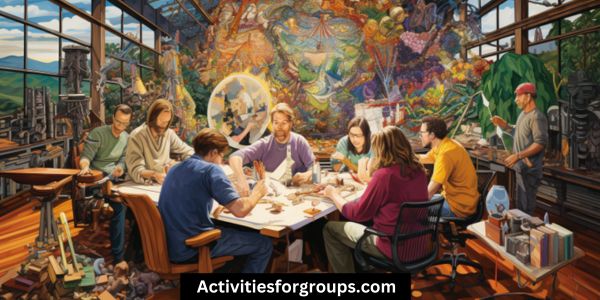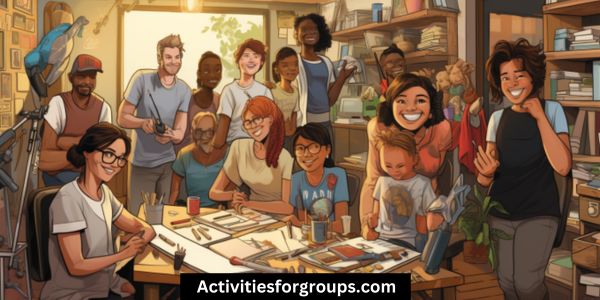Are you looking for an environmentally-friendly group art project? Whether you’re looking to use upcycled materials, create something from discarded items, or even use natural dyes, there are plenty of creative and eco-friendly ideas.

Let’s explore some inspiring projects, like recycling art, community projects, and more!
Upcycling Materials
Frequently, you and your team can upcycle materials to create unique pieces of art. Reusing and repurposing items, such as alternative fabrics, can help you create a unique piece of art without buying new materials.
You can also use a variety of digital collages to create an eye-catching piece. For example, you can collect old magazines and use the pages to piece together a beautiful collage.
If you’re feeling crafty, you and your group can use fabric scraps and buttons to sew a patchwork quilt. Additionally, you can use old newspaper to make a paper mâché sculpture or a recycled newspaper basket.
Reusing Discarded Items
How else can you and your group reuse discarded items to create a unique piece of art?
Eco design and sustainable materials are two concepts that can help you think of creative ways to use discarded items. For instance, you and your group can collect old newspapers, magazines, or plastic bottles to create a mosaic mural. With a bit of creativity, you can turn these discarded items into a colourful piece of art.
Additionally, you can also use old tyres, wood, cardboard, or fabric to build a sculpture together. Repurposing materials is a great way to come up with unique art that stands out. It also allows you to be eco-friendly while exploring different techniques and materials.
Moreover, you can also get creative with paint. You can use paint and other discarded items to create a 3D painting or a textured art piece. Whatever project you decide to do, make sure to have fun with it!
Natural Dyes

Plus, you can make your own natural dyes using items from your pantry or garden, such as lemons, onion skins, and berries.
Natural dyes are a great way to introduce environmentally-friendly group art projects, as they use biodegradable materials like fruits, vegetables, and flowers. This type of project can be used to dye sustainable fabrics, including cotton, linen, and hemp.
Additionally, the dyes can be used to color paper, wood, or other materials. Group art projects that involve natural dyes can be used to create anything from colorful t-shirts to wall tapestries.
Natural dyes are also great for exploring the world of color, as they can be mixed and blended to create a vast array of shades and hues.
With a few basic supplies, a group of people can work together to create beautiful and unique art pieces using natural dyes. Natural dyes aren’t only a great way to create art, but also to learn about the environment and sustainable living.
Recycling Art
Another great way to explore environmentally-friendly group art projects is through recycling art. There are a variety of activities that encourage creativity while also reducing waste. Here are some ideas to help you get started:
- Eco Painting:
- Gather old newspapers, magazines, and other scrap paper.
- Cut the paper into shapes and sizes for a unique collage.
- Use eco-friendly paints to color in the shapes.
- Upcycling:
- Look for items around the house that can be reused.
- Try using plastic bottles, cardboard, and old fabric for sculpture and other 3D projects.
- Think of creative ways to repurpose these items.
- Green Crafts:
- Use natural items like leaves, twigs, and pine cones to create art.
- Collect items from nature and turn them into decorations.
- Add eco-friendly touches with recycled materials.
With these ideas, your group can create meaningful art projects that support a sustainable future.
Community Projects

Additionally, from recycling art to community projects, there are many ways for groups to create art that’s both meaningful and eco-friendly.
Community projects are a great way to get people involved in green initiatives. One idea is to work together to create a community garden.
This could include painting or decorating large planters, planting flowers, and designing pathways. Plants and flowers can help to clean the air, and it’s a great way for the community to come together and create something beautiful.
Another idea is to create a mural for a public space. This can be done with recycled materials and can bring awareness to a particular environmental cause. It also serves to beautify the space and can be a great conversation starter.
Groups can also come up with their own creative ideas that involve community involvement and environmental awareness. No matter which project is chosen, it will be meaningful and eco-friendly.
Frequently Asked Questions
What Materials Are Best for Upcycling?
You’ll find many benefits of upcycling! Sustainable materials such as wood, cardboard, and fabric are great for creating unique pieces of art. With some creativity, these materials can be transformed into something new and beautiful.
Are There Any Safety Precautions to Consider When Reusing Discarded Items?
When reusing items, ensure you follow safe recycling habits and sustainable sourcing. Wear gloves and check for sharp edges, mold, and other hazards.
What Natural Dyes Are Available?
You can source eco friendly paints and natural dyes from plants, fungi, and insects. Consider using berries, flowers, turmeric, and other natural items to create vibrant colors.
What Are the Best Ways to Recycle Art?
You can reduce waste and repurpose materials by recycling art. Reuse canvas, frames, and materials, donate or resell art supplies, and consider digital art or 3D printing.
How Can I Organize a Community Art Project?
Organize a community art project by encouraging creative solutions and involving the community. Brainstorm ideas together and get everyone involved.
Conclusion
Group art projects can be a great way to get creative while being environmentally-friendly. From upcycling materials to reusing discarded items, natural dyes to recycling art, there are plenty of ways to get creative and help the environment at the same time.
So why not get together with friends and family and make something beautiful while making a positive impact on the planet?




Leave a Reply